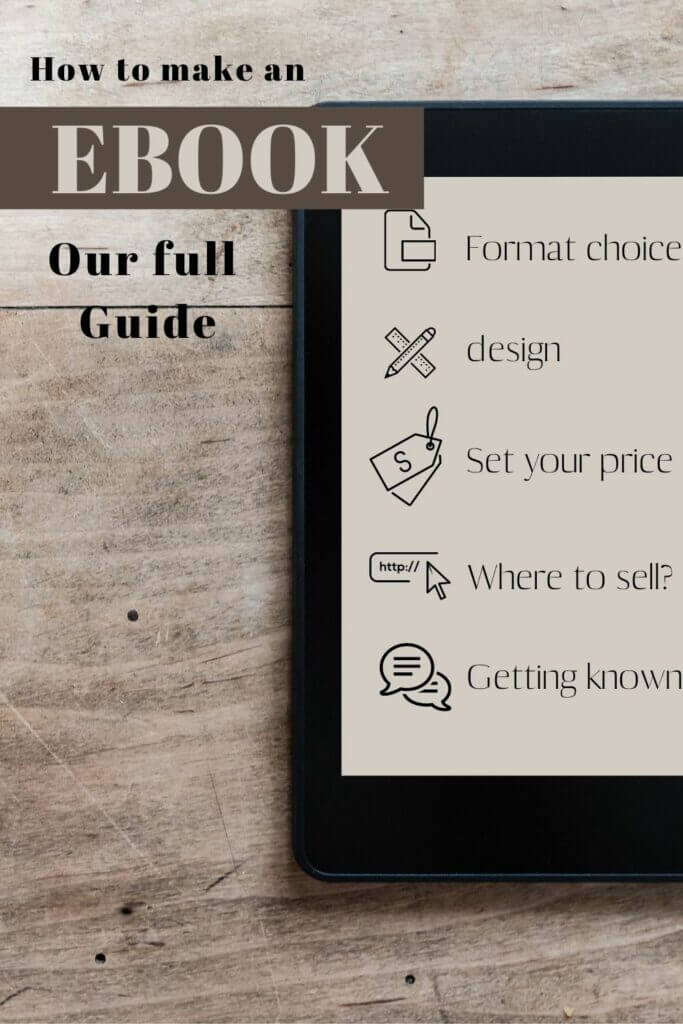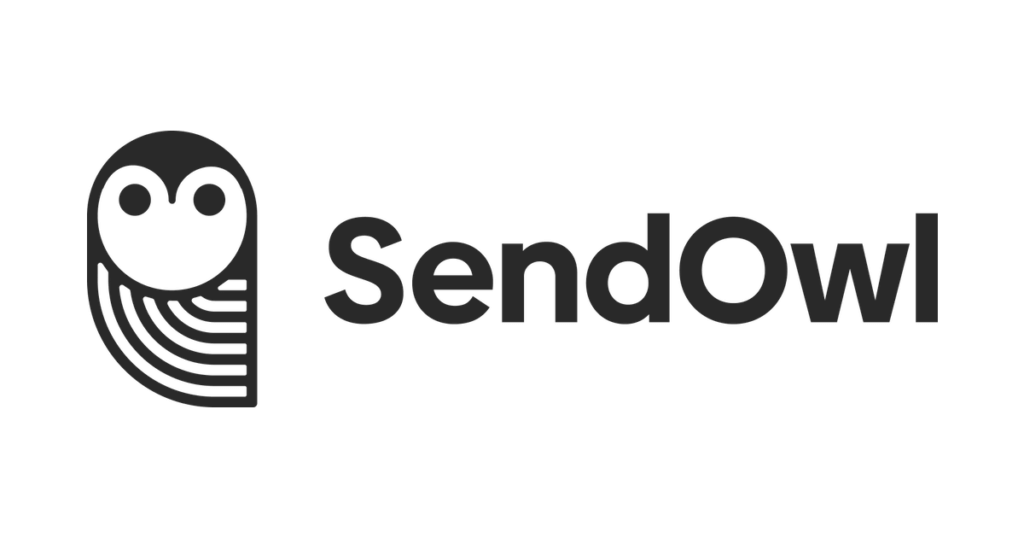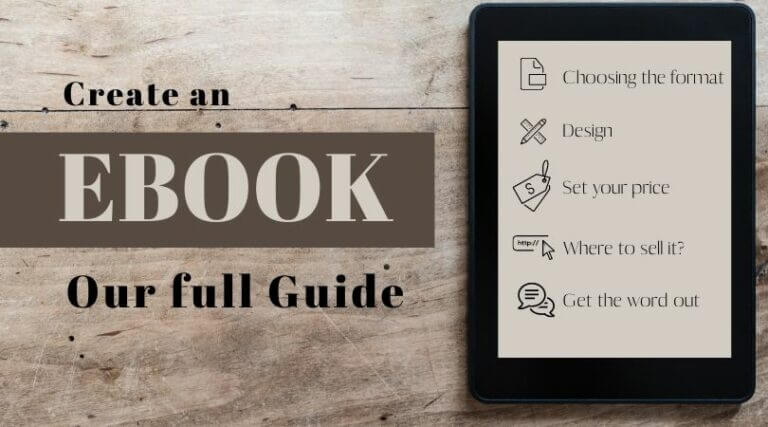
You want to create your first ebook and you don’t know where to start? Are you wondering about the format, the layout, the sales platform or how to price and promote your digital product? Then don’t move, you’re in the right place!
On our travel blog novo-monde we have published 3 ebooks over the years: 1 free and 2 paid. In this article we offer you a little feedback and all our advice to start well in the adventure of publishing a digital book.
Choice of ebook format: epub or PDF?
When you start to think about your ebook, there is inevitably a moment where the question of the format comes up. In the field of ebooks there are (roughly speaking) 2 main options: the e-reader formats and the PDF.
While the first one allows to be totally adapted to the e-readers and especially it allows the user to freely choose his font size, the second one is a more “fixed” and universal layout.

If we decide to opt for a e-reader format, there are a multitude of formats but 2 clearly stand out in terms of market share: ePub (the standard format of most e-readers) and the Kindle format (Mobi, AZW and KF8 being the 3 file type versions). Amazon’s devices run on a “closed” system and therefore only accept files in these formats.
In the world of novels and e-books with a large majority of text, it is generally recommended to use the ePub and/or Kindle format because it is generally the most comfortable to read and, above all, it allows you to sell your content on the platforms in question (Amazon, Fnac, AppStore, etc…)
However, if you follow our blog Novo-Monde you may have noticed that we have chosen to propose our ebooks mainly in PDF format (we did create epubs versions for the Via Alpina and our free ebook to prepare a world tour to test).
If we made this choice it is mainly for 2 reasons:
- The vast majority of sales are made on our platforms
- Our ebooks being richly illustrated, a standard ePub format is very complicated to set up. Indeed, with the possibility of changing the font size, the layout quickly becomes VERY chaotic.
With hindsight we are fully satisfied with the PDF format for the use we have of it. Although this format is sometimes seen as “old-fashioned” in the world of digital books, we are convinced that it is still the best format for very richly illustrated ebooks.
For our Via Alpina ebook we simply created an ePub file but forced a “fixed” layout which means that the reader will be able to find our ebooks on the different selling platforms but when reading he will not be able to adjust the font sizes and will always have the design we created (he will only be able to zoom and not adjust).
To create an ePub or Kindle file the procedure is relatively simple (at least if the ebook contains mainly text) and there are many software and online tutorials that allow you to do it. Unfortunately, we can’t give you details in this article because this is a part we didn’t do (we had hired someone to convert ours via the Fiverr platform… Just search for “pdf to epub conversion” if you want to hire someone there.
Layout and Design of the ebook
Once you have written your content, there is still one very important step: the layout and visual rendering of your ebook! For a “novel” type ebook containing mainly text, things are relatively trivial: a well readable font, an adapted font size, a well spaced text with adapted paragraphs and a nice cover image and the trick is so to speak done.
On the other hand, if like us, you start with a more illustrated ebook, the design becomes a key point! To give you an example, here are 2 versions of our first ebook “How to prepare a round the world trip“:
(Note: the ebook is available in English as well in case you’re interested. 🙂 The first layout was made in French only, that’s why I decided to leave the French screenshots)
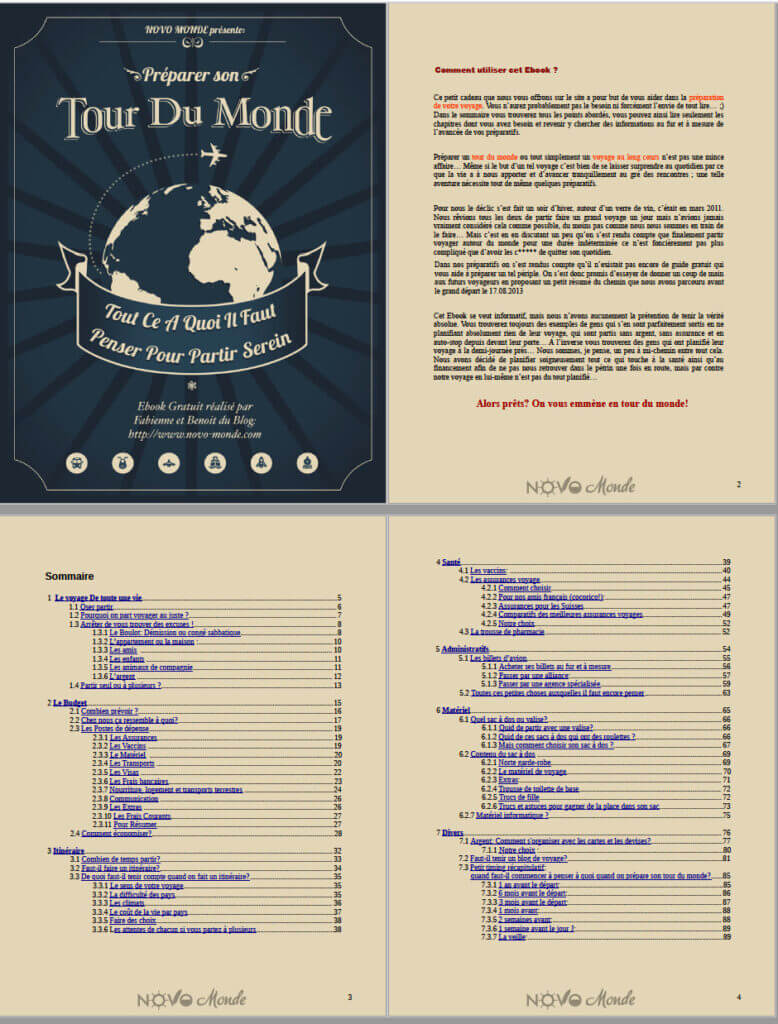
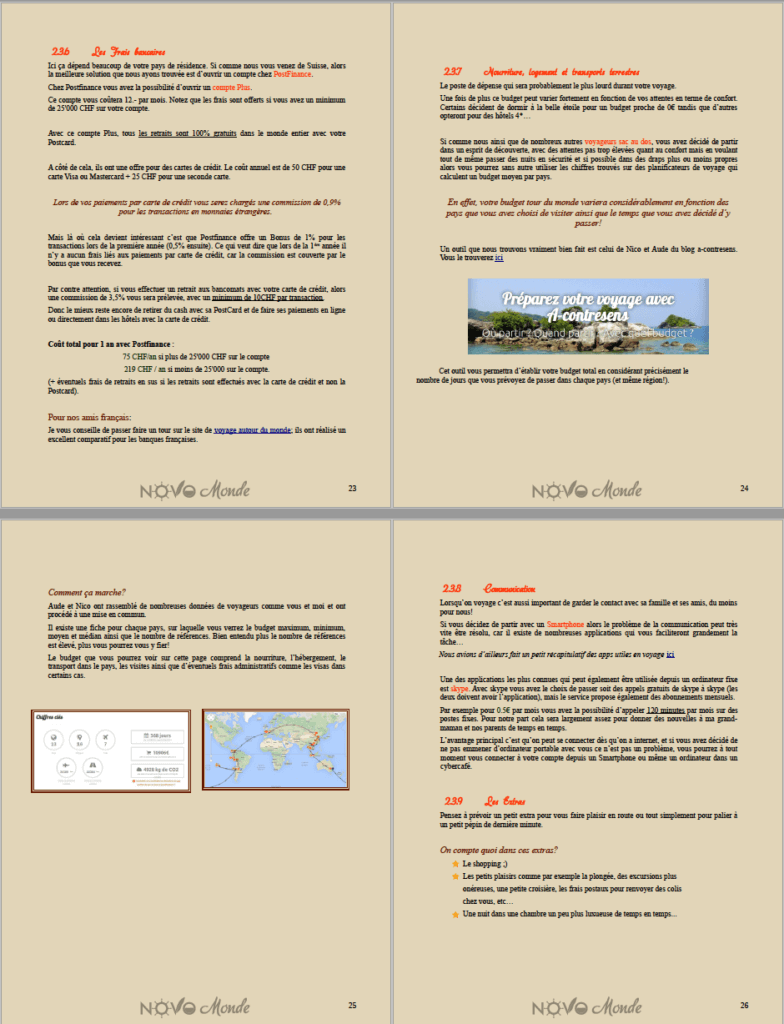
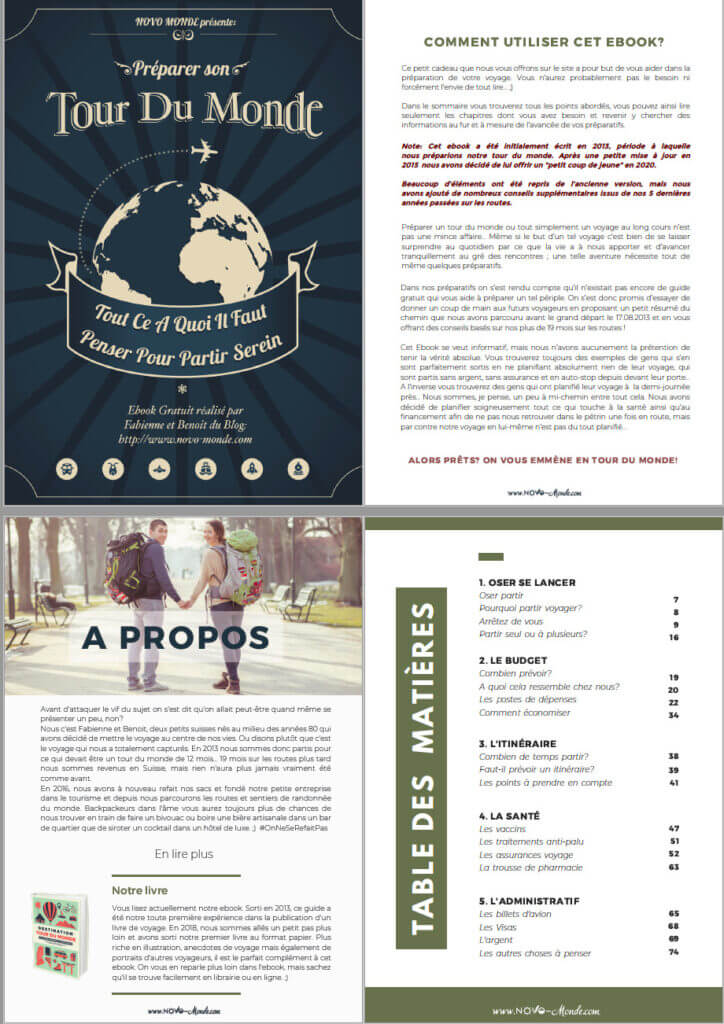
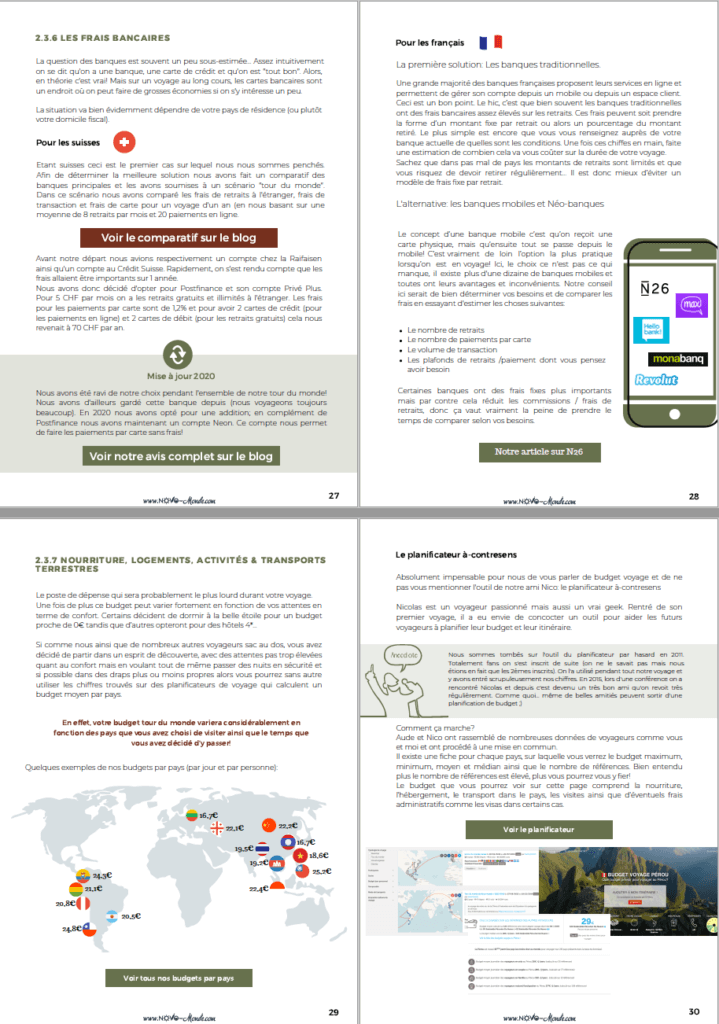
It is exactly the same content, but with a different layout. Although the second version is not what we would call “flawless” you will certainly admit that it is more appealing, right?
I decided to use Canva for the layout of our ebooks. If you follow some simple rules, you’ll quickly get a homogeneous and pleasant to read result. To go further into the subject of design, I invite you to read our special article Layout & Design of ebook. You will find all my advices as well as the reference sites I use every day to help me in the creation of ebooks.
Read the blog post about ebook Design
How to set the price of your ebook?
When you finish your ebook, you usually have to think about its distribution. How will it be sold (we talk about it below) but also and especially: How much can it be sold for? What are the different monetization models for an ebook?
When it comes to ebook monetization there are 3 main options. Each one has its advantages and disadvantages. Here is a quick overview:
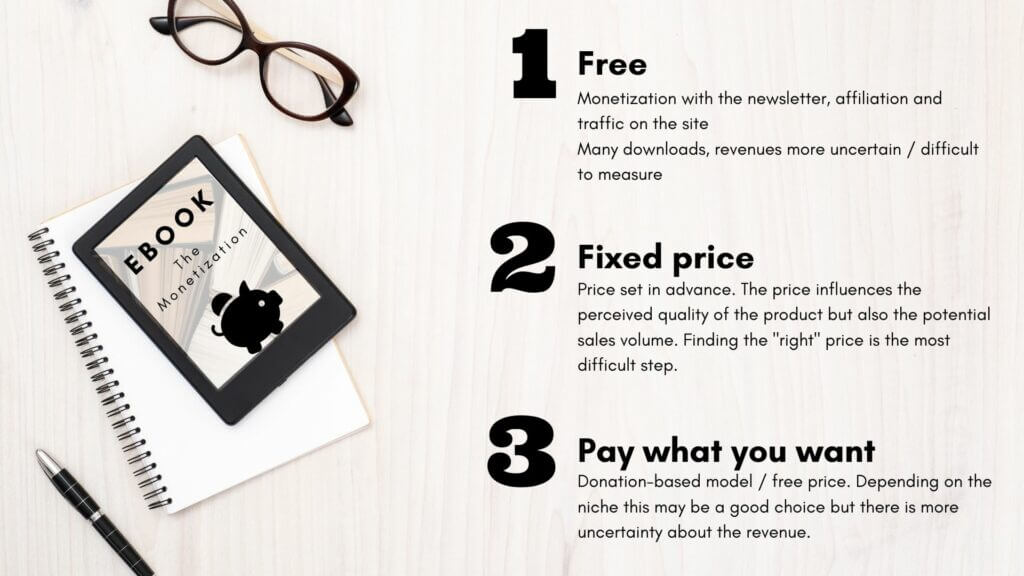
Free Ebook: the model to maximize downloads
Let’s start with the free version! Now you’re probably thinking I’m weird… we’re talking about monetization and my first suggestion is to give away an ebook for free? Yes, yes, it is indeed a form of monetization!
In fact, you have to be aware that in the world of the web (and business in general) there is often an inverse relationship between price and sales volume. Of course this does not apply to VERY specific themes where people are generally willing to pay more but let’s say it’s a general rule. By offering your ebook for free you remove a big barrier to all those who “hesitate” or who are not 100% convinced that the ebook will please them / bring what they are looking for.

Giving away an ebook “for free” doesn’t mean that you can’t monetize it, quite the contrary! The most common way to monetize a free ebook is to ask for an email address in exchange. This is an excellent way to create a list of relevant emails of people interested in the theme of the said ebook. A well thought out and optimized newsletter can be a very interesting source of income (this is a subject that we may come back to in a future article if you’re interested! Otherwise you can also check out our guide on emailing and newsletter tools for WordPress).
The second way to monetize a free ebook is to include affiliate links or simply links back to the contents of your site (which are monetized).
The last point, not to be neglected, is the trust factor! If you offer quality content for free (and I really insist on this point), it goes a long way in affirming your authority on a given subject and inspiring confidence. If in the future you offer another paid ebook, there is a good chance that those who enjoyed your free ebook will be more inclined to spend some money for the next one.
Example: Our free ebook on how to prepare a round the world trip
In 2013 we had published our very first ebook: How to prepare a round the world trip. At the time, the question of selling it had not really arisen… Our audience was still small and we really wanted to “offer” this content to future travellers and build up an email address base (even if at the time we weren’t necessarily thinking about monetizing it yet).
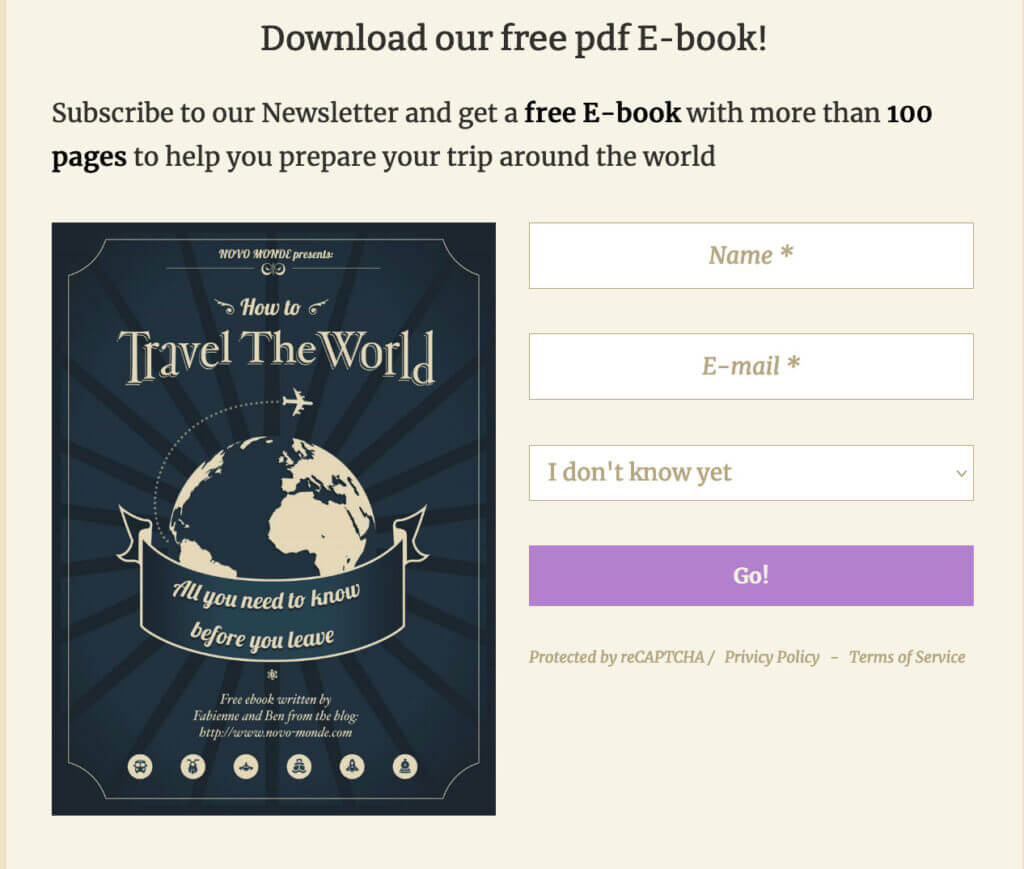
Since then, we have made many, many updates to this guide and it now contains over 100 pages. Clearly, this is now a very complete guide that we would have loved to have before embarking on our trip! Despite all the updates and the significant increase of our audience we decided to keep it free. Why did we decide to keep it free? The first reason would surely be that it’s simply a desire to keep the spirit of the “beginning”, but not only… Over the years, our ebook has been downloaded more than 6000 times and many travelers have come across our site thanks to it. In the ebook we are very transparent about how we make a living, especially about the fact that to go on a round the world trip it is highly recommended to have a travel insurance. We make it clear that if people go through our site, they don’t pay anything extra but we do get a commission (for some insurance companies they even get a discount). Many readers of our ebook decide to go through our links to “thank” us for the free content we offer.
It is obviously difficult to measure exactly what this ebook brings us financially each month, but in our eyes, offering it for free was clearly the best decision.
Selling your ebook at a fixed price: how to determine the “right” price?
When you decide to sell your ebook, there always comes a moment when you ask yourself the question “how much“. This step is very important because finding the “right” price is not always easy.
In fact, the price will depend on 5 main factors:
- The theme of the ebook and the “added value”. Pure entertainment content such as novels are generally sold at a lower price than products that provide information (courses, guides, etc.).
- The length of the ebook. The relationship here is clearly not linear… a well-constructed 30-page ebook can provide much more value than a messy 300-page ebook, but let’s just say that overall it will be difficult to justify a high price for a very short ebook.
- Pricing and the presence of competing products. The more the ebook is about a researched and unaddressed topic, the easier it will be to justify a higher price.
- The sales platform: In “direct” sales (i.e. a pdf on your website), you are generally free to set your price according to your audience. As soon as you go on platforms like Amazon, Kobo, Apple, the situation changes… On Amazon for example, the author gets a 70% commission on the selling price only when the price is between 2,99€ and 9,99€. For books sold at higher or lower prices, the commission is only 35%. So you have to do your calculations carefully… 😉
- Your objectives in terms of revenue / sales volume: An ebook sold “cheaper” will trigger more spontaneous purchases but will obviously bring you less per sale (especially since on each sale you have to deduct bank fees, platform fees, etc.). After all, it’s better to sell 2000 copies at 10€ than 150 copies at 30€…
For your information, our current ebooks are sold at 15€ for 31 hikes in Valais and Chablais and 20€ for our ebook on the Via Alpina Switzerland. We have opted for a more premium pricing model with discount options for sharing (more on this in the marketing section below).
Flexible ebook price: Everyone pays what they want

Finally, the third option that many content creators consider: offering their product at a “Pay what you want” price or for a donation. This model is a bit of a “hybrid” of the two above. Those who read us regularly and want to support us can put in more, while the one who discovers our content can have a free preview or at a low price.
I personally like the idea of this monetization method even if, unfortunately, I think it is not necessarily the most profitable unless you include affiliation or links pointing to your own monetized content… We have not yet tested this form of selling for ebooks, but we have applied it to our Novo-Map plugin. This plugin is a project that Benoit wanted to do and instead of putting it on sale, we put buttons to make donations.
In the software world this monetization method is more often used and among developers it is quite common to send each other donations (we do it regularly for plugins we use). But when it comes to the “general public” this practice is simply not very popular. Our plugin has been downloaded more than 17’000 times since 2017… The amount of donations? 302€… spread over about 40 contributors 😉
I’m glad we didn’t do this project for money! haha
We probably wouldn’t have reached 17’000 downloads if we had sold it for 10€, but clearly we would have earned much more than 300€ 😉
The platforms to sell your ebook in PDF format
If you have decided to opt for an ePub or Kindle format, you will probably have put your digital book online on the corresponding platform (Amazon, Fnac, etc). But of course, nothing prevents you from also offering the ebook for download in the format of your choice from your website! If you have written an ebook in PDF format, “direct” sales will be your only option.
If like us you have a website or a blog, it would be a shame not to use its notoriety and its traffic to generate sales. When it comes to selling digital products, there are two schools of thought: Sell via third-party platforms or integrate the sale directly into your website.
Sell your ebooks via a third party platform: Payhip, Sendowl, E-Junkie, Gumroad, etc.
We will start with the simplest method: selling via specialized platforms. There are many platforms that allow you to sell digital goods easily, the best known are probably Payhip, Sendowl, E-Junkie, Podia or Gumroad.
What these platforms have in common is that they manage everything related to downloading and payment on their side while providing sellers with marketing tools. Their use is ultra simple: you create an account, choose your package, add your files and payment details, create your store and you are ready to start selling!
In our research we found that 2 of these services really stand out compared to the others (in terms of price on the one hand but also for the features offered): Payhip and Sendowl.
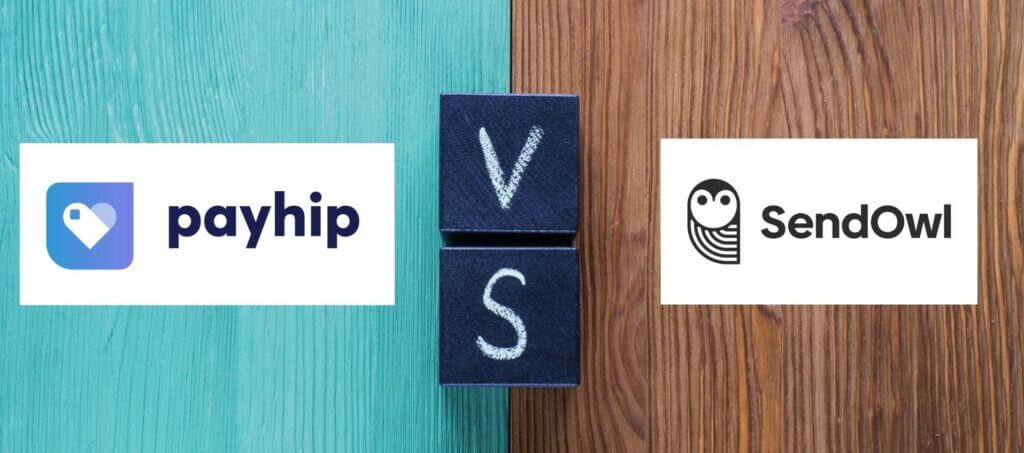
Before we talk about what makes these two platforms different, let’s start with what they have in common:
- A very pleasant and intuitive interface
- The possibility to offer affiliation on your products
- Integration of all the most common payment methods (credit cards, Paypal)
- Option to create personalized emails for your customers
- The purchase can be done on the sale page of the platforms but can also be integrated directly on your own website through a widget
In terms of differences, there are relatively few, but there are some important ones.
What Payhip has more (in our opinion):
- Payhip is the only platform to offer social discounts (which means that you get a discount if your buyers share your ebook)
- The design of the sales page is much more flexible on Payhip
- The number of products is unlimited
- Payhip offers a free version
What Sendowl has in addition:
- At the time of payment the language and currency can be adjusted according to the country of your buyer
- No transaction fees (but you have to pay a subscription)
- a more advanced and flexible affiliate module than payhip
- possibility to pay with apple pay
Let’s compare the prices of these 2 services.
If you arrived on this article, I will assume that you are starting with the sale of digital products and I will focus on the “basic” versions of these platforms (in basic you can already have up to 30 ebooks in Sendowl so it is already not bad to start) 😉
Payhip has 2 simple plans:
- A 100% free version but where they take 5% commission on all sales.
- A “Plus” version at $29/month where the commission is 2% (financially, this option becomes advantageous from $1000 of monthly turnover)
Sendowl has more than 10 plans but we will focus on the 2 simplest ones:
- The “Basic” version at 9$ per month. No commission, but on the other hand very limited functionalities (little customization, no possibility to use an affiliate program).
- The “Standard” version at 15$ per month. This version includes customization and the affiliate module. In my opinion, this is the best option to start with Sendowl.
The match is clearly between Payhip in free version and the Standard version of Sendowl. In fact, to know which one is more advantageous, everything will depend on your sales volume.
Payhip takes 5% commission while Sendowl Standard costs $180 per year (without taking any commission). A little calculation later and we realize that the paid version becomes profitable when you sell more than 3600$ per year…
If, like us, you are just starting to sell ebooks and you don’t know the potential of your market yet, then it may be less risky to start with Payhip, which is what we have done.
For our part, the above reasoning should make us change our platform actually… This first year our ebook sales have been excellent and we’ve far exceeded that amount. But for now we like the “Social Discount” feature and, let’s be honest, we don’t feel like taking the time to make all the changes, or at least not right away 😉
Sell your ebooks directly on your website – use e-commerce plugins
The alternative to using third party sites is to do everything directly “on your site”. This means that you are the one who will manage the storage of the files as well as the financial transactions. Of course there is no need to code everything yourself and there are plugins / extensions for that. Easy Digital Download (specialized in digital products) or WooCommerce (general sales platform for wordpress sites).
The advantage of these solutions is of course that everything becomes infinitely customizable! But why didn’t we opt for this solution? There are several reasons for this…
- Selling products online is not our core business. We wanted a quick solution that did not require too much integration time.
- The relatively high price associated with the various features (WooCommerce is free, but all the extensions required to have additional features are paid)
- These plugins have the annoying tendency to impact the loading speed of a site. Benoit being a fan of loading speed optimization, it gave him chills just to imagine optimizing our sites again with these plugins 😉
Ebook marketing: our tips
Once the ebook is finalized and put online there is still an important part of the work: selling it! If your ebook is on sale on third party platforms like Amazon, Kobo, or Apple it will obviously be found in their search engines, but overall it is better not to wait for people to “accidentally” stumble upon your product 😉
1: Tell your network about your ebook and include it in your content!
It sounds silly when you say it like that, but how many content creators spend weeks or months writing quality content and then “just publish it on the blog”.

When we release a product, we should not hesitate to put it forward in our old contents (generally those which already benefit from a better natural referencing). To give you an example, when we released our latest ebook on hiking in the Valais we went back in all the articles talking about both hiking and the Valais region (as well as neighboring regions) and we included a brief presentation of the ebook and a link to the more detailed presentation page. You’d be surprised by the number of people who come to our site to find information about a walk in the vineyards of Lavaux or the tour des “dents du midi” and decide to take our ebook for their future escapades 😉
The same goes for your “private” network. So obviously I’m not talking about spamming all your friends and family, but sometimes a simple post or message explaining that a share could help spread the word about your product can trigger many shares. A lot of people don’t mean bad by not sharing, they just don’t think about it.
2: Work on your ebook SEO
As for a blog article, it is important to work on the SEO of your ebook. The idea is obviously that potential buyers arrive directly on the page of your ebook because it meets their expectations (without necessarily being already readers of your site).
When I talk about SEO, I’m not talking about the content of your ebook (the content of a PDF file for download cannot be interpreted and understood by Google) but about the “satellite” content you will create to promote your product. If you are a beginner in SEO or if you just want to refresh your memory, you can read our complete SEO guide.
But to summarize, writing a good ebook is good, but then you must also think about how to put it forward on your site: creation of qualitative content in the theme, choice of keywords, url, title, meta-data, internal linking, obtaining back-link, etc…
Our Via Alpina ebook is a compendium of hiking stories and practical advice & maps. This ebook sells very well because it clearly meets the expectations of people who decide to start a Via Alpina and who are in the preparation phase.
On our website we have created a “sales” page where we present the guidebook in detail, but around that there are 8 other articles/pages that give detailed and qualitative information about the Via Alpina. These articles are more focused on inspiration and although they give practical information, the most advanced practical points are exclusively in the ebook. The contents support each other without cannibalizing each other.
In fact, it is important to realize that people are often not specifically looking for an ebook, they are looking for information. For example, the term “via alpina suisse” generates more than 1000 searches per month, while the term “ebook via alpina” is only searched about ten times per month… It is easy to imagine on which it is better to try to position yourself 😉
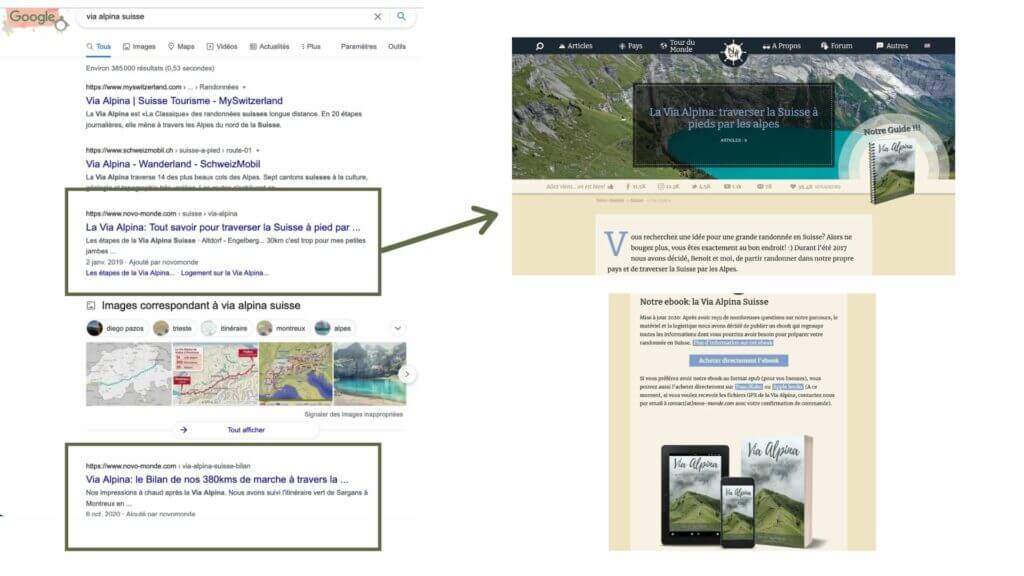
With our very rich content on the subject, we managed to position 2 of our articles in the top 4 of Google results on this query. On all our pages the ebook is obviously highlighted.
3: Create a sales page and attractive sharing visuals for your ebook
As much as it is important to take care of the layout of your ebook, you should not neglect the final presentation of the latter. What do I mean by this? In fact, this remark will apply to 2 to 3 axes (depending on the sales method chosen):
- Your product presentation page on your site/blog: Your blog/site will certainly be the first place a buyer will come in contact with your ebook. It is important here to present in detail the product you are selling: number of pages, price, format, content type, practical information. Personally I like it when an author also explains a little about his motivations for writing an ebook… It gives a more personal touch to the product.
- The sales page on the platform: Here the design will obviously depend on the platform you have chosen, but let’s just say that it is important to take the time to describe and illustrate your sales page. For example, offer screenshots or a free excerpt of your ebook so that the buyer can get a clear idea of what to expect.
- Sharing visuals: This last point is often neglected and yet I find it very important! Whether on Facebook, Twitter, etc., when an article is shared there is always an image that is generated (the preview). If no sharing image has been defined in the open graphs, social networks usually take the first image of the article and they will stretch it so that it “fits” in the format.
To illustrate point 3 I had fun comparing what our ebook presentation pages would look like if I hadn’t created cover images. Admit it’s less engaging?

If we hadn’t taken 10 minutes in Canva to make a “simple” visual then every time someone shares our ebooks, their contacts would see the images in the second row. In short: take care of your sharing visuals! For more info on sharing visuals on social networks, you can read our article here.
4: Offer affiliation on your ebooks
For 9 years now that we have been running our travel blog, affiliation has been and remains our favorite way of monetization. In this spirit, it quickly seemed natural and logical to offer a commission to people/blogs that would help us spread the word about our ebooks. Having affiliates allows you to have content created around your ebook but also and especially to potentially reach a new clientele.
To set up affiliation on an ebook, the easiest way is usually to have a sales platform that directly integrates this functionality. This is why we chose Payhip above.
In Payhip, the amount of the commission can be freely set by the creator of the ebook. In the “affiliate world” there are many levels of compensation, but if you want to get an idea I would say that a 10% commission is a bit of an industry standard. For an ebook we think you can go a bit higher. Maybe we say this because we are usually on the other side (as an affiliate) but from the start we chose to offer an attractive 25% commission. Offering an attractive commission is certainly giving up part of your income, but it also encourages and motivates the content creators to put more emphasis on the product. For us, affiliation is really a win-win model that we recommend!
5: Reward your customers for sharing your ebook
Having chosen Payhip as our selling platform we took the opportunity to use their feature called “social discount”. We can freely choose the amount of the discount and for our part we decided to offer 25% discount to buyers who decide to share our ebook on their social networks.
Why do this? On the one hand it is a way to thank the people who help us to make our ebook known. The other point, not negligible, is the potential sales that it can bring. It is not uncommon for a person interested in the theme of an ebook (hiking in our case) to have in his contacts people who share the same passion. In the end, it’s a bit the same logic that applies to affiliation 😉
There, this time I think we’ve told you everything we know about ebook creation. We hope that this little guide will be useful to you and that your digital book projects will come true. If you have more specific questions or comments on what we’ve said, feel free to leave us a little comment at the end of the article or open a topic on our forum.
Note: This article contains affiliate links. By passing through our links you do not pay anything extra but we will get a small commission. Thank you for your support.
Pin it

